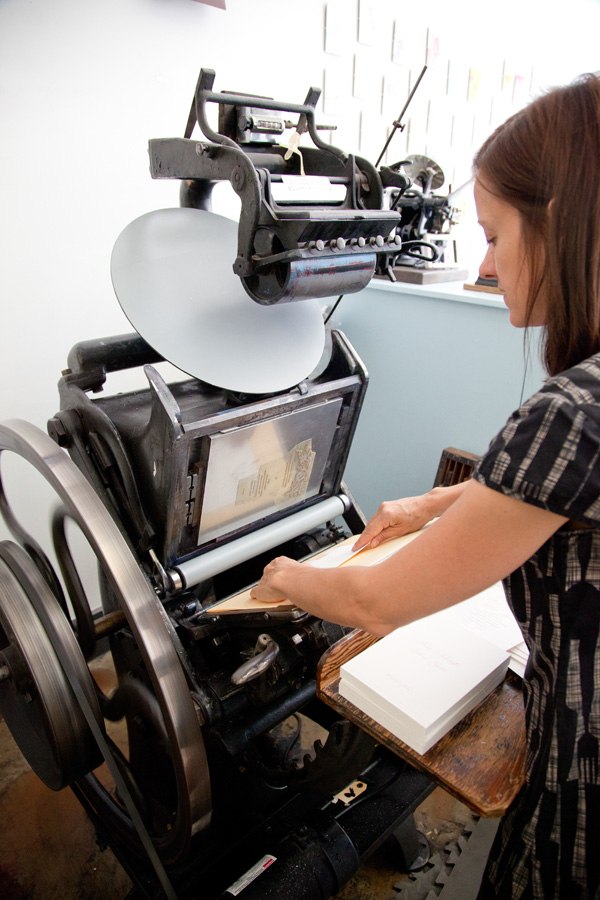
 As the nexus of Brooklyn’s tech community, Dumbo is best known for its digital landscape. But tucked in amongst its startup companies and art galleries on Washington Street is the studio of Sesame Letterpress and Design where Breck Hostetter makes a living as a printmaker creating cards, stationary and other printed curiosities through a process that’s been around for over five centuries.
As the nexus of Brooklyn’s tech community, Dumbo is best known for its digital landscape. But tucked in amongst its startup companies and art galleries on Washington Street is the studio of Sesame Letterpress and Design where Breck Hostetter makes a living as a printmaker creating cards, stationary and other printed curiosities through a process that’s been around for over five centuries.
“It’s an original method of printing or publishing,” she explains. “We tend to work with 19th century presses. Most of ours are from the 1880s and 1890s. We stick with that style because we really like it. There’s also just something so beautiful about the machine and the way it works that its kind of close to our heart, so we stayed with that era.”
The era Hostetter refers to is known as the Victorian Period, which ended with the death of Queen Victoria, the British monarch, in 1901, and was better known as the Gilded Age on this side of the Atlantic Ocean. It’s a period of time that not only produced the presses Hostetter uses to create everything from stationary and invitations to coasters, cards and calendars, but it also produced the inspiration for much of the illustration she adds to her designs.
“We really, really love the Victorian design,” she says. “There’s so much thought to detail and different elements. We also like incorporating a lot of modern aesthetics like color, clean design and bright paper.”
A letterpress bookmark in the shape of an ornate hairpin that fans out on top like a sea shell and would have been used to finish off an updo in the 19th century is printed in hot pink ink–as is another bookmark in the shape of an Art Deco perfume bottle. Tags with profiled silhouettes of animals, a woman in an off-the-shoulder ball gown and a man in the bowler hat and suit, are reminiscent of classic cameo carvings.
Even this year’s selection of holiday cards and gift tags harkens back to a bygone era with designs like a 19th-century colonial house with two smokestacks, garland under its windows and a tree on either end blowing in an unfelt wind. Another holiday card looks like a classic tree ornament that’s been printed in an electric blue ink and holds a miniature cityscape of New York in a snow globe at its center. Each design is sold in a set of eight with envelopes for $20.
“I really like the idea of making something that’s so special that you really want to slow down and focus on it and look at it–something that kind of warms your heart,” Hostetter says. “Holiday cards happen to be a little tricky. There’s a lot of bright, funny things out there, and there’s a lot of kind of classic, gilded things, but we really wanted to do a collection that was timeless and really beautiful. We went with fine, fine detail to make them special cards.”

Designs like this card-stock calendar for the year to come are created by Breck Hostetter (above left) and printed on 100-plus-year-old presses at her studio in Dumbo. Photos: Sesame Letterpress
Hostetter, who has a background in fine arts and bought her first printing press in 1999, designs all the artwork that winds up on her presses, though, she says, the process is a collaborative one often times between herself and a client or her staff. All her designs are done digitally then transferred onto plates. (She’s been using polymer plates more frequently as of late.) Each one is three-dimensional and the imagery, type and details are raised, so that when ink is applied to each plate then pressed onto the paper, only the artwork and writing is transferred. She and a small team split the production between a dozen different presses, which take up much of the space in her studio. Each press is allocated to a different task depending on orders. Hostetter estimates she can produce about 150 pages in an hour with her process.
“They’re kind of these old pieces of equipment that work differently on different days,” she says. “Some days the set up is really, really quick. Some days the ink tends to be a little stickier so it goes a little slower.”
Despite all the digital advancements that make reaching out to touch someone so much easier today (e-invites, text messages and Facebook poking among the more disconnected options), there is something to be said for sending a message via snail mail on a lovely piece of stationary that stands the centuries.
“When you think about how wonderful it is to come upon a note that you’ve gotten from someone,” Hostetter says, “you do slow down and you stop and read these and look at the handwriting. There’s something so thoughtful and so sweet, and there’s also something that seems almost unreal about it now. It’s so far from how we usually communicate that it’s really, really special. I’m just happy to be a part of that tradition.”

